The answer to the mystery of which KTM is best is simple. Or not.
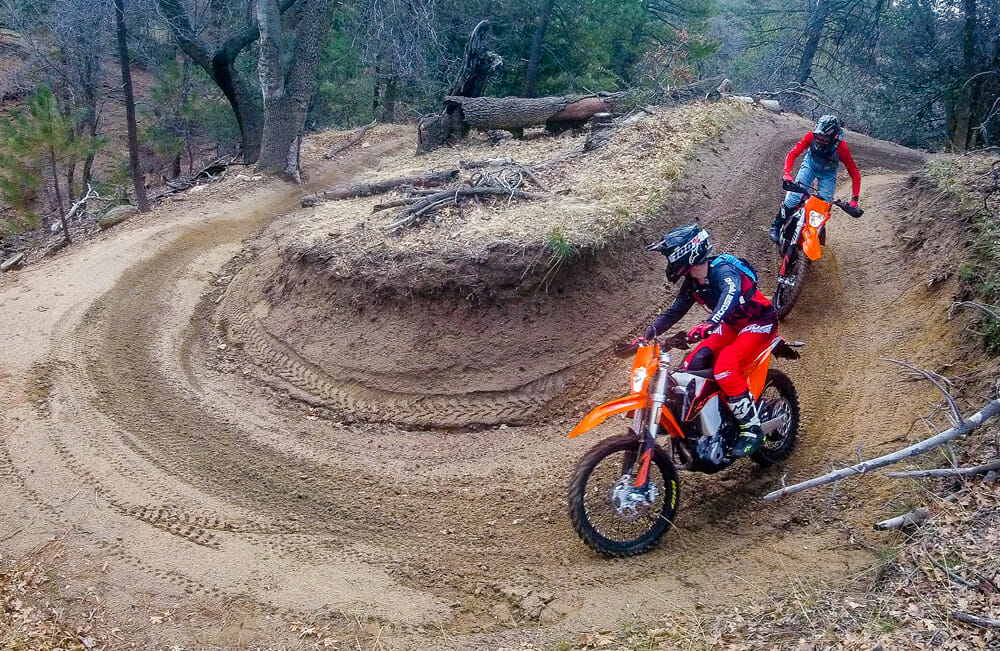
Photography by Brent Culbertson and Sean Finley
What’s the difference between an EXC-F and XCF-W, anyway? On paper, it’s not a lot. Basically, one’s got a license plate on the back and the other does not. Legality, however, that’s a huge difference, but what about on the trail? What about performance? Is there a huge difference here, too? We wanted to know! And there’s only one way to find out—we rode them. We took them into the trees and into the desert in search of answers.
But first. To keep things on an even playing field, we installed Dunlop AT81 off-road tires on both bikes to evaluate trail performance for this test. And the EXC got a KTM PowerParts skid plate. Otherwise, we rode them in showroom stock condition.
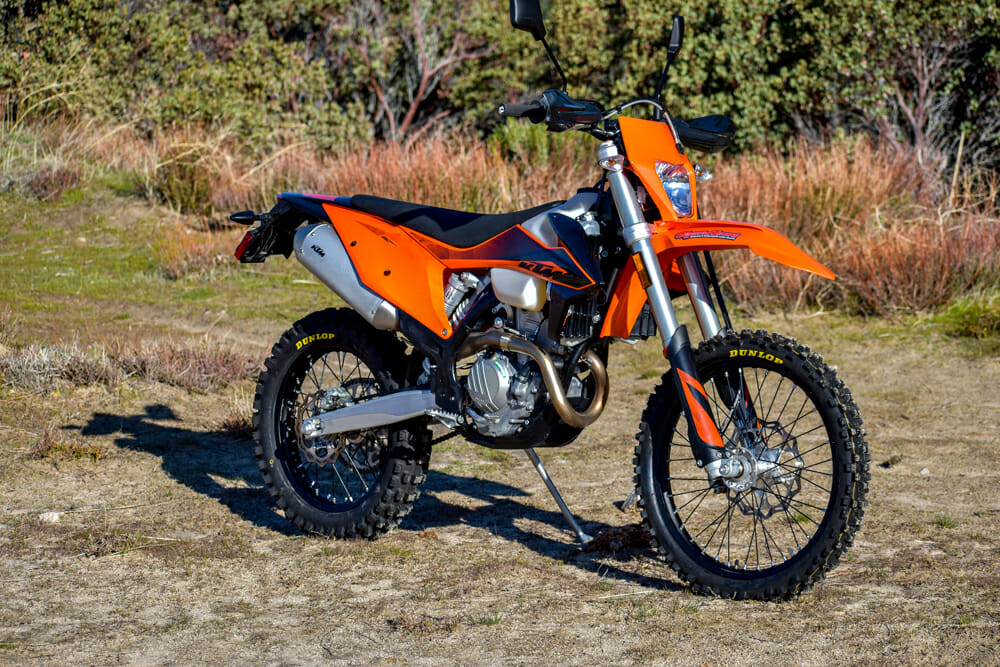
The Short Of It
If you need the legality or want the convenience of a license plate on your dirt bike to access your favorite trail networks, explore new terrain, or increase the opportunity to ride, this buying debate is already over. Buy an EXC and enjoy.
Our testing found the XCF-W doesn’t provide a level of improved performance worth being bound by street-legal road borders or running from cops. Likewise, the EXC comes with little-to-no-compromise.
Buy an EXC. Swap the tires. Rip! There are plenty of street-legal dirt bike tires out there—end of discussion. Congrats on the new bike. Have a great day.
Of course, that’s not the end of the discussion.
If you don’t need a license plate or its convenience on your dirt bike, your trail riding area is vast, or your locale allows you to ride anything this side of a homemade rocket on the street, then the XCF-W is a better choice. It has elevated performance and less blinky stuff to break off. It’s also about $500 cheaper.
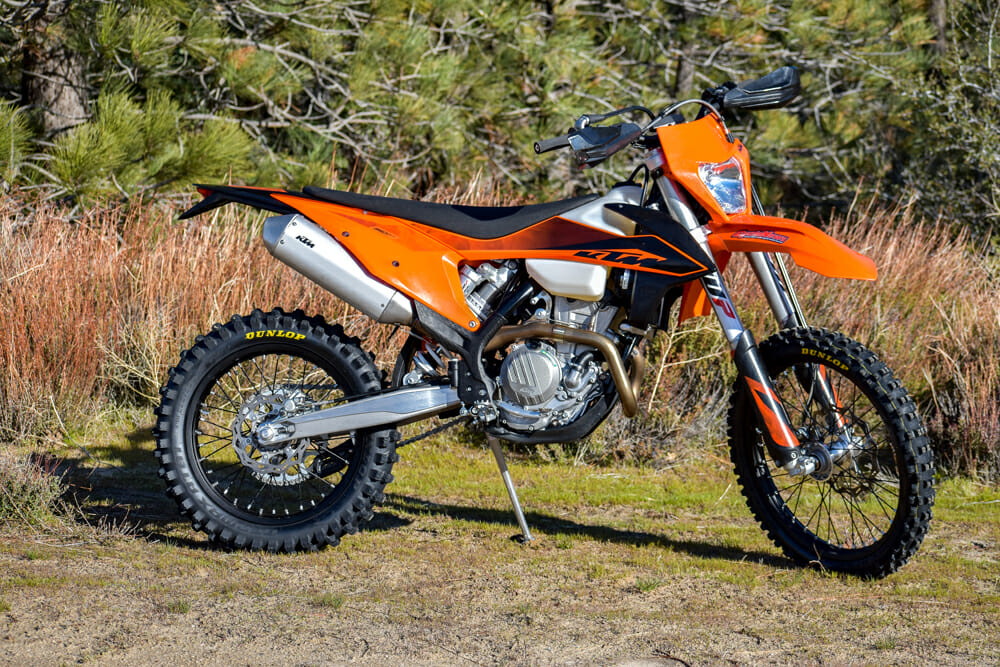
Universal Updates
Both of these bikes come into 2020 with a host of updates for the new season. New bodywork and graphics showcase the new bikes but underneath lies a whole pile of new componentry.
Both bikes get a new frame and subframe, which are the latest platform updates we covered in our two-stroke TPI reviews late last year (Click here to read the 2020 KTM 250 XC-W TPI Review and here for the 2020 KTM 250 XC TPI Review). The result? More stiffness and improved handling. Likewise, both get updated WP Xplor forks and new shock settings and parts. An updated mid-valve in the fork aims to provide a more consistent ride, and the adjusters on the fork caps are easier to turn. The shock has softer settings in the PDS system.
Ergonomically, both bikes take on a new seat and fuel tank. A new airbox is featured, as well.
Header pipes are now two-piece units for easier fitting, and the mufflers are all new, as well.
The cooling system is updated with lower radiators to drop the center of gravity a bit, and the cooling circuit is optimized with a larger center tube. The radiator guards are new for more impact protection.
Each bike has a new throttle body and updated cable routing. And the engine gets a new, lighter cylinder head, updated ports and cam timing, a shorter cylinder to drop the rotating masses, a higher compression CP brand piston, new lighter engine cases with improved main bearing oil supply, and new Pankl transmission material to increase durability.
Lots of new stuff!
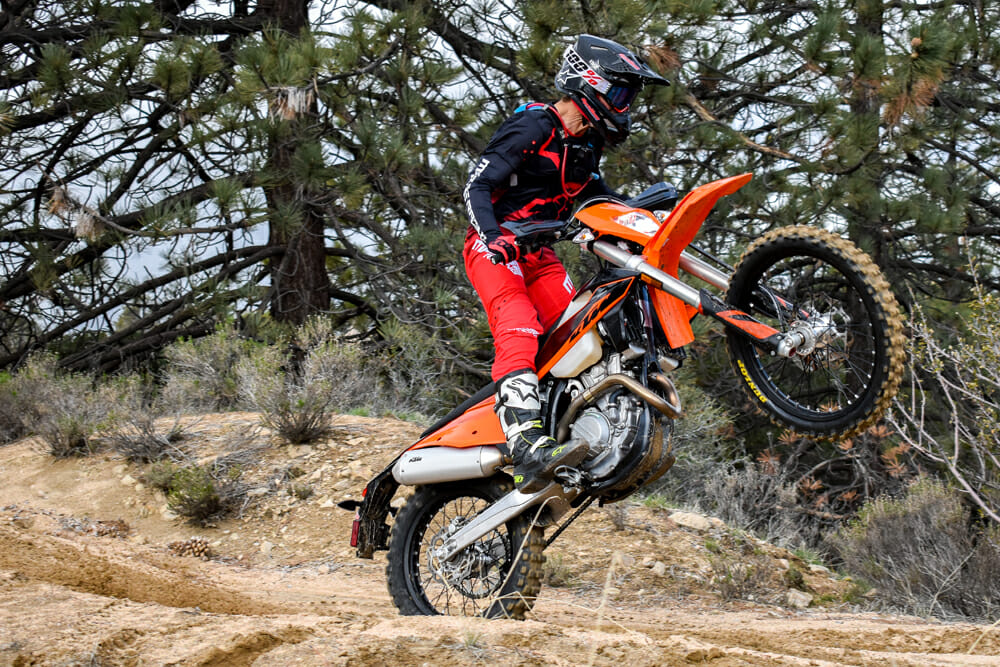
The EXC-F Compromise: Mythical Beast or Reality
There are a lot of opinions on what you can and can’t do with, or do and don’t need, when it comes to off-road motorcycles. The perception of KTM EXCs is varied regionally with riders using them successfully in stock trim across all terrain and others condemning them for being over-regulated.
Our experiences are the former, and while friends at KTM have added six-speed transmissions to 450 XC models in the past, or highly modified their EXCs with tuners and do-dads, we tend to ride stock EXCs and enjoy ourselves. The alleged compromises just don’t come up very often. And we need the license plate to ride the good stuff.
There is one exception here: a 450 EXC doesn’t always exist. For 2020, there’s a 350 and 500 model in the U.S. So, if you want a 450’s power character but don’t want a 500, you’re out of luck in the six-speed, street-legal and longer-distance off-road world. There is an XC-F, but that’s closer to a motocross bike than a trail slayer. You’re relegated to putting a six-speed in an XC-F. Here, we avoid the compromises that it brings and choose 500 EXC every time.
Still, the debate on what you need or what works will rage until robots ride our bikes for us.
What’s hardly debatable is this: KTM’s line of off-road machines, plastered with license plates or not, set benchmarks in performance. They set the street-legal dirt bike bar so high that the response from brands they don’t own continues to be less-than-competitive in most areas. They’re not the most comfortable, true. But Austrian-built “dual-sport” bikes are the favorites in any performance matchup we can foresee, weak comfort/road manners and all.
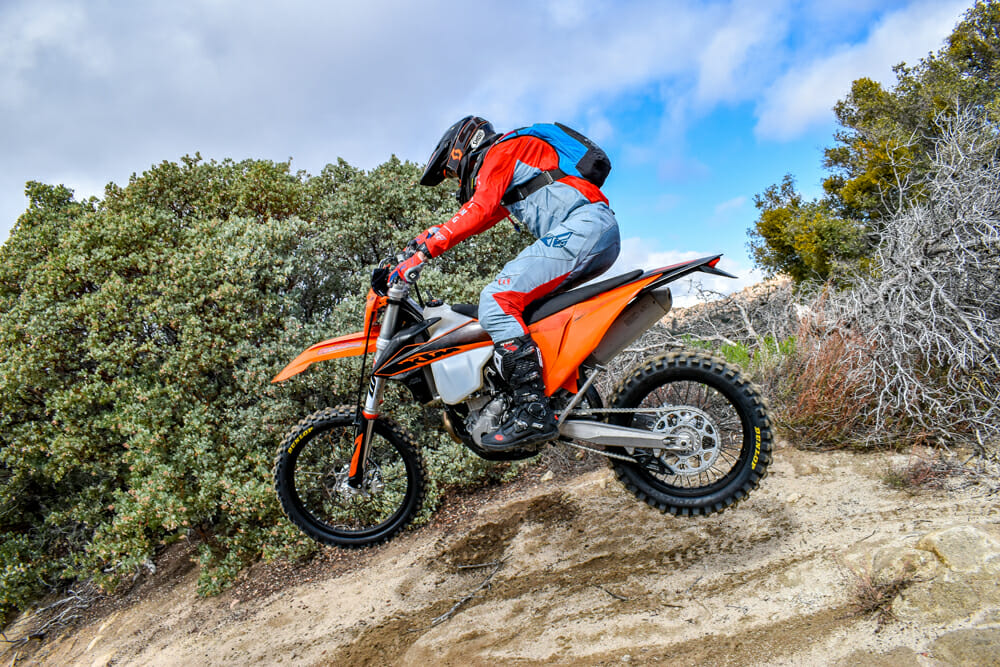
What the EXC-F Has / XCF-W has not
The EXC is more regulated than an XCF-W with a perforated end cap added to the final muffler tip and corresponding fuel/ignition map tuned for the exhaust system. Therefore, it has lower total power and sound output. We can safely assume this is the result of hitting the drive-by sound emission regulation target. The same goes for the Continental TKC80 stock tires. They are remarkably quieter at a decent clip or while accelerating on the pavement—where the sound test is taken.
The EXC also has the blinky bits for turning, a sweet horn, a wiring harness connecting that stuff to a bar switch, some reflectors for being seen, terrible stock mirrors, and a license plate bracket you’ll probably break off. For a $500 premium, that’s the stuff you get along with 50-state street legality.
Our 2020 KTM 350 EXC weighs 253 pounds full of fuel with Dunlop AT81s in place of the Continental TKC80 stock tires and the addition of the KTM PowerParts plastic skid plate.
What the XCF-W Has / EXC-F Has Not
KTM’s new XCF-W line is more aggressive than the EXC but is still 50-state off-road legal all year long (California green sticker). Its power output isn’t stifled by the final perforated muffler screen, and it has its own mapping to complement the more free-flowing exhaust system.
XCF-W’s get competition-level upgrades in the dual-map switch and traction control so that you can manipulate power delivery in four levels, essentially. These features are excellent on KTM’s SX-F and XC line of race bikes. The XCF-W gets Dunlop AT81s and a skid plate standard.
Our 2020 KTM 350 XCF-W weighs 248 pounds full of fuel in completely showroom stock trim. So, there’s a five-pound weight advantage going to the XCF-W here head to head.
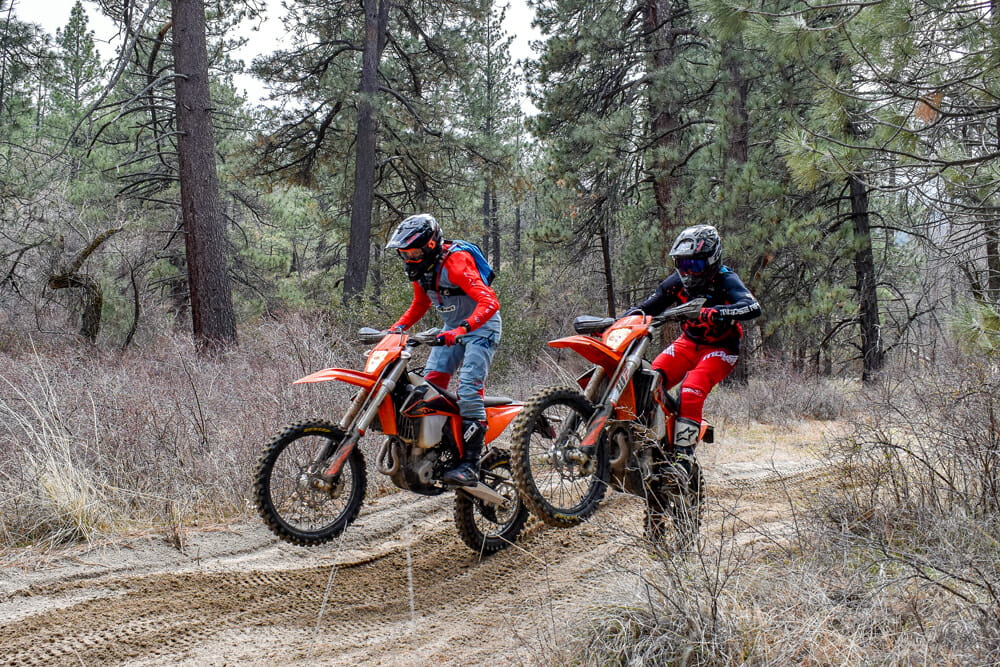
Power Difference
The total power difference between an EXC-F and XCF-W is debated. We’re tempted to pull some dyno runs and check since we’re holding on to the bikes for a bit, but it doesn’t really matter what the total power output is when you ride on the trail. Remember, this reduction in power is primarily to reduce noise during a drive-by test via mapping and a more restrictive exhaust. So, the power loss is at the peak of the curve as the drive-by test is done at a percentage of rpm based on peak power rpm. If you lower peak power, the drive-by rpm lowers.
In our real-world testing, we found a small but noticeable difference in back-to-back riding on roll-on power and overall peppiness. The XCF-W sounds and feels a bit more alive than the EXC, but the overall difference in trail-flow situations isn’t drastic. The muffled sound of the EXC makes it feel a little more mellow than it really is, too. The bottom line, there’s minimal difference on flowing trails and fun two-track and single-track between the two bikes.
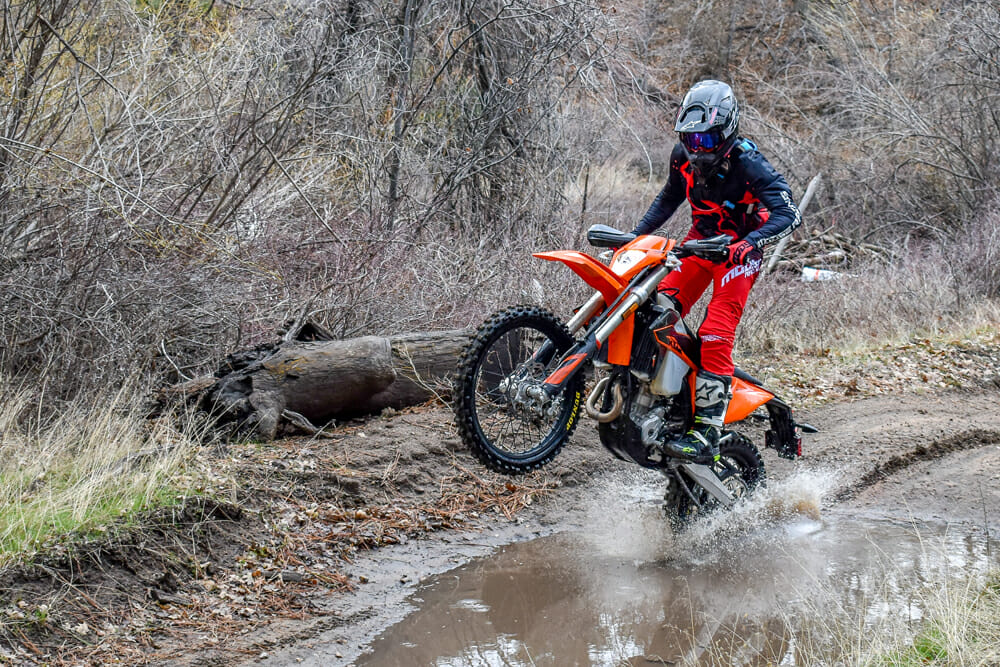
As the trail gets more technical, subtle advantages rise to the top in the XCF-W’s favor. The EXC has a slightly higher tendency to stall at ultra-low rpm and rapid throttle movements. The lean fuel mapping and sloppy throttle whacking are mostly to blame. With a little focus and attention, the stall can easily be mitigated out of the EXC for the tightest terrain and slowest speeds.
Since the EXC’s powerplant is muffled, it manufactures amazing traction and low-rpm grunt that is right at home in technical riding. Still, the XCF-W has this performance amplified and is less reluctant to stall when we get sloppy with the throttle. Both bikes pull gears well, and the 350 base is as robust as a trail climber. It doesn’t make massive off-bottom power, so it translates into highly controllable fun.
In more open desert terrain and faster trails, the XCF-W gets to the shifts sooner than the EXC and enjoys the 350 engine’s penchant for surging out of the mid- to the top-end. Remember, this is the same engine platform that has pulled holeshots on 450 motocross bikes if the start straight is long enough. This motor makes power to the moon, and the XCF-W gets to where you want to go sooner. While the peak pull on the EXC is slightly less, it only really shows up in longer, sustained-load hillclimbs—similarly, we presume, to what a dyno chart would show.
The final word on power in this comparison is this: For where we and most people ride the EXC and XCF-Ws, the power difference is noticeable but minimal. The buying decision goes back to whether or not you need a license plate. Any compromises you might fear are more or less irrelevant.
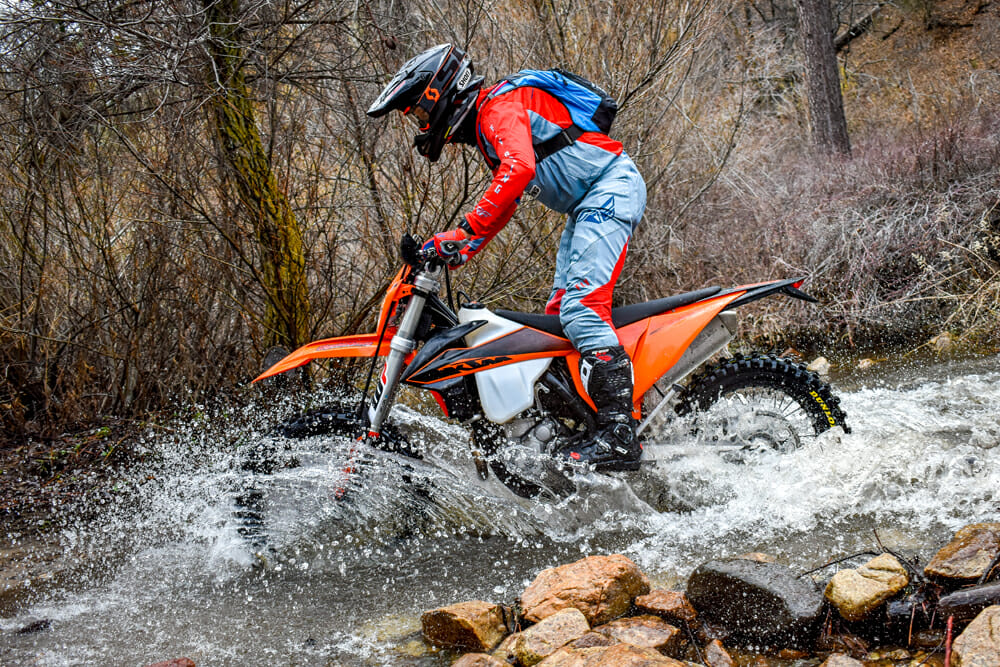
Handling
Since these bikes are identical outside the mentioned details, the frame and suspension and ergonomics of them all are equal. And they perform superbly. The Xplor suspension lineup is perfect for trail poking to aggressive wheel-tapping of whoops. And the chassis remain planted and predictable through it all. These bikes feel as light as two-strokes often, and the power delivery of the 350 unit is ultimately controllable, making for a solid platform for all riders, beginners to advanced, with small compromises in weight feel only noticeable if you’re lofting the front wheel and swinging it around. That’s the only time they feel like a four-stroke.
Final Decision
The final answer for which bike is best for you depends on two things more than anything—you and where you intend to ride. The performance difference isn’t enough to worry about. And the perceived compromise in choosing an EXC-F is more mythical than reality.
Your location and the geography you pop wheelies upon will determine which KTM off-road model is right for you. If you need a street-legal bike to link all your favorite trails together or ride through the neighborhood with your kids in your lap, buy an EXC-F. If you don’t and you want to save some cash, buy an XCF-W. CN
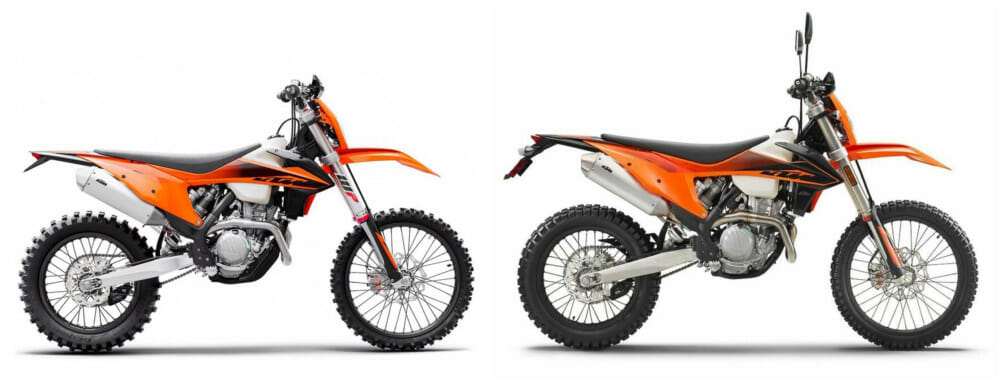
2020 KTM 350 XCF-W / 350 EXC-F Specifications
| MSRP: | $10,499 / $10,999 |
| Engine: | Liquid-cooled, 4-stroke, DOHC, 4-valve, single |
| Displacement: | 349.7cc |
| Bore x Stroke: | 88 x 57.5mm |
| Compression Ratio: | 14.2:1 |
| Lubrication: | Pressure lubrication with 2 oil pumps |
| Starting System: | Electric |
| Transmission: | 6-speed, wide ratio |
| Clutch: | Wet, DDS multi-disc, Brembo hydraulics |
| Fueling: | EFI Keihin, 44mm throttle body |
| Ignition: | KTM EMS |
| Frame: | Central double-cradle-type 25CrMo4 steel |
| Front Suspension: | WP-USD Xplor 48mm, fully adjustable |
| Rear Suspension: | WP Xplor PDS, single shock, fully adjustable |
| Front-Wheel Travel: | 12.2 in. |
| Rear-Wheel Travel: | 11.8 in. |
| Front Tire: | 90/90×21 in. Dunlop AT81 / Continental TKC 80 |
| Rear Tire: | 110/100×18 in. Dunlop AT81 / Continental TKC 80 |
| Front Brake: | Brembo 2-piston floating caliper, 260mm disc |
| Rear Brake: | Brembo 1-piston floating caliper, 220mm disc |
| Final Drive: | X-Ring chain, 14/52T |
| Rake: | 26.5° |
| Triple Clamp Offset: | 22mm |
| Wheelbase: | 58.3 in. |
| Seat Height: | 37.8 in. |
| Ground Clearance: | 14.6 in. |
| Fuel Capacity: | 2.25 gal. |
| Weight (wet, actual): | 248 lbs. / 253 lbs. |
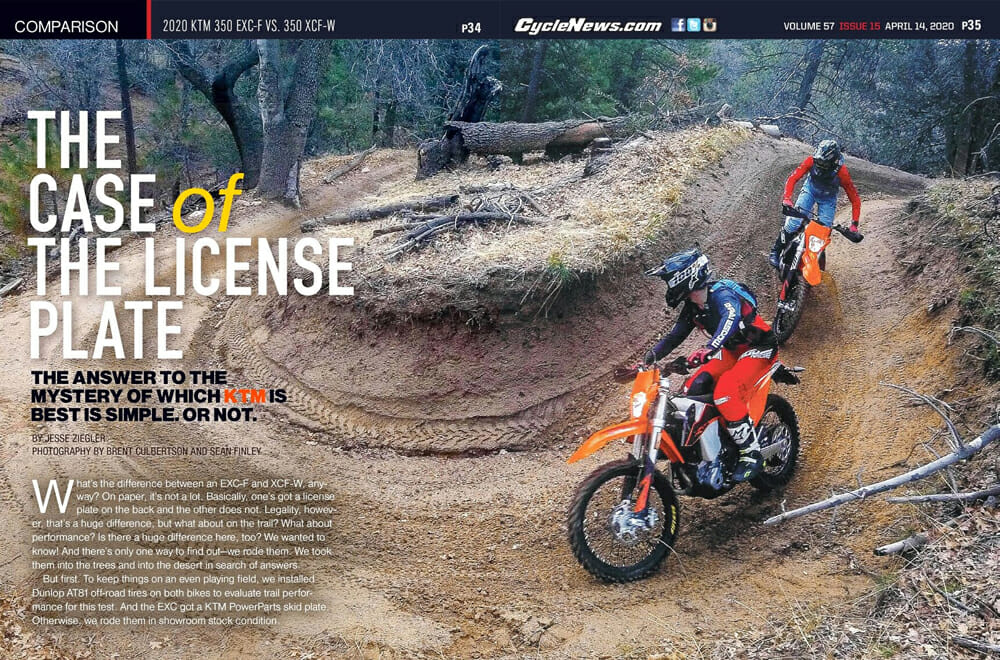
Click here to read the 2020 KTM 350 EXC-F vs. 350 XCF-W Comparison in the Cycle News Digital Edition Magazine.
Click here for the latest Cycle News Off-Road motorcycle reviews and news.
Click here for more KTM motorcycle reviews and news.
